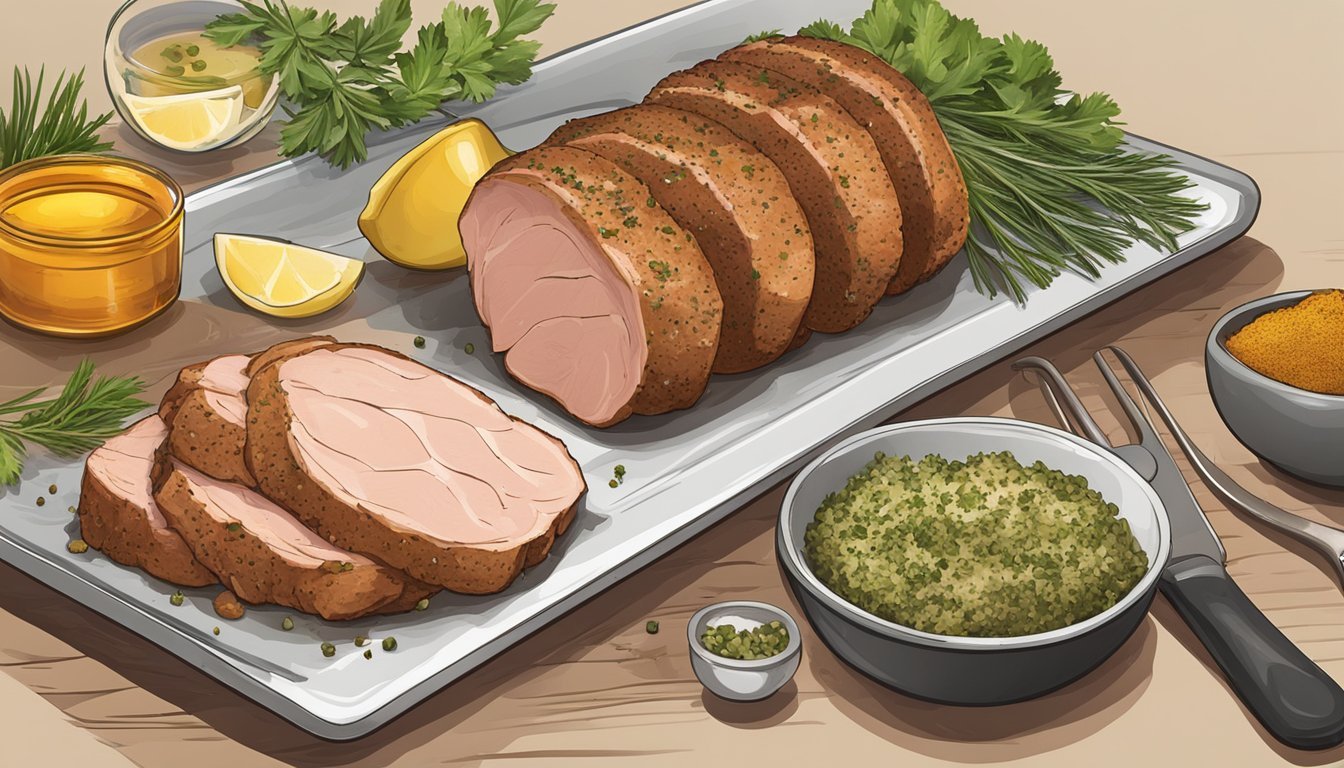Pork Tenderloin Substitutes
Top Alternatives for Any Recipe
For those looking to explore other options in their culinary journey, finding the perfect substitute for pork tenderloin can be a valuable endeavor. Chicken breast, a lean and versatile meat option, can easily replace pork tenderloin while retaining a similar flavor profile and texture. It can be used in a variety of recipes, ensuring that your dishes remain flavorful and satisfying.
Another substitute worth considering is turkey tenderloin. This cut provides a juicy alternative, fitting seamlessly into many pork tenderloin recipes. It's a leaner option but still packs a delectable flavor, ideal for large family dinners.
Plant-based alternatives like tofu and seitan also offer great versatility. Firm tofu, when marinated and cooked properly, can mimic the texture of pork tenderloin. Seitan, made from wheat gluten, can be seasoned to achieve a similar taste, making it an excellent choice for those seeking meat-free options.
Understanding Pork Tenderloin
Pork tenderloin is a lean and tender cut known for its quick cooking time and versatile culinary applications. This section will cover the primary characteristics, culinary uses, and cooking techniques for pork tenderloin.
Characteristics of Pork Tenderloin
Pork tenderloin is a slender, cylindrical cut taken from the muscle that runs along the backbone of the pig.
It is renowned for being lean and tender, making it one of the most sought-after cuts. Tenderloin has a mild flavor and a fine grain, providing a delicate texture.
With its low-fat content, it’s a healthier option, but this means extra care is needed to avoid overcooking. Weighing around 1 to 1.5 pounds, pork tenderloin is typically smaller than other cuts.
Culinary Applications
Pork tenderloin is highly versatile and used in a wide array of recipes.
Grilling and roasting are popular cooking methods, enhancing its natural flavors. It can also be sliced into medallions for quick pan-searing or incorporated into stir-fries.
Marinades, rubs, and sauces complement its mild taste, adding depth and variety to dishes. Pork tenderloin pairs well with diverse ingredients, from herbs to sweet glazes, making it a staple in both gourmet and everyday cooking.
Cooking Pork Tenderloin to Perfection
To cook pork tenderloin to perfection, attention to internal temperature is crucial.
The ideal internal temperature is 145°F (63°C), ensuring the meat remains juicy and tender. Use a meat thermometer to check doneness accurately. Due to its leanness, pork tenderloin has a quick cooking time, typically around 20-30 minutes when roasted or grilled.
Resting the meat for 5-10 minutes after cooking allows the juices to redistribute, enhancing its flavor and texture.
By following these steps, pork tenderloin can be a delightful addition to any meal.
Beef Tenderloin and Other Meat Substitutes
When considering substitutes for pork tenderloin, it’s essential to explore beef tenderloin and other meats that offer similar qualities in terms of texture, fat content, and overall flavor. Each alternative brings its own unique benefits to various dishes.
Beef Tenderloin as an Alternative
Beef tenderloin stands out as an excellent substitute for pork tenderloin. It is tender, flavorful, and versatile, fitting well into recipes that require a lean cut of meat. Due to its low-fat content and delicate texture, beef tenderloin can be cooked quickly without compromising taste. This cut works best in dishes where maintaining tenderness is crucial, such as steaks or roasts. When using beef tenderloin, it’s important to mind cooking times to avoid overcooking and drying out the meat.
Other Meat Alternatives
Beyond beef tenderloin, several other meats can serve as suitable replacements for pork tenderloin. Beef ribeye steak, for example, offers a richly marbled texture that enhances flavor, making it ideal for grilling or searing. Lamb loin provides a slightly gamier taste, appealing to those seeking a more robust alternative. Turkey tenderloin is a lean and mild option suitable for a variety of cooking methods, including roasting and grilling. These alternatives can mimic the tenderness and lean qualities of pork tenderloin while introducing diverse flavors.
Pork Chops for Stews and Slow-Cooking
For dishes that involve stews or slow cooking, pork chops present a viable substitute. Their bone-in structure and marbled fat content contribute to rich flavors and tender meat when cooked over longer periods. Pork chops are ideal for recipes requiring a hearty, comforting profile, as their fat and meat meld seamlessly to create a succulent texture. This makes them suitable for braises, slow-cooked stews, and other dishes that benefit from extended cooking times.
Chicken Options
Chicken breasts are another option, especially for those looking for a lean, versatile substitute. They are easy to cook and can absorb a variety of marinades and spices, making them suitable for numerous recipes that originally call for pork tenderloin. When substituting chicken breast, it's important to adjust cooking times to avoid dryness. For a slightly richer flavor and juicier result, chicken thighs can be used as well. These cuts offer balance between leanness and moisture, adapting well to grilling, roasting, or searing.
When selecting a substitute for pork tenderloin, consider the cooking method and desired flavor profile. Each alternative offers unique attributes, supporting a wide range of culinary creations.
Vegetarian and Vegan Substitutes
When looking for alternatives to pork tenderloin, there are several vegetarian and vegan options that can replicate its texture and flavor. The most popular substitutes include tofu, jackfruit, and mushrooms, each offering unique culinary possibilities.
Tofu Variations
Tofu is a versatile soybean product that can be adapted to resemble pork tenderloin in various dishes. Firm tofu holds its shape well and can be marinated to infuse flavors deeply.
Marinating: Use a mixture of soy sauce, garlic, and ginger to create a savory base. Let the tofu sit for at least 30 minutes to soak up the flavors.
Cooking Methods: Tofu can be grilled, baked, or stir-fried. Grilling and baking provide a chewy texture, similar to grilled pork tenderloin.
Seitan Mix: Combining tofu with seitan (wheat gluten) can enhance the texture, mimicking the firmness and bite of tenderloin.
Jackfruit and Mushroom Choices
Jackfruit: Young green jackfruit has a meat-like texture and can be shredded to resemble pulled pork. It works well in slow-cooked dishes and absorbs spices efficiently.
Portobello Mushrooms: These large mushrooms have a dense, meaty texture. They can be sliced or kept whole and grilled or roasted to replicate the tenderness and smoky flavor of pork tenderloin.
Chanterelle Mushrooms: Known for their rich and slightly fruity flavor, they can be used in stews or sautéed with spices like cumin, coriander, and chili powder for a flavor-packed experience.
Integrating Vegetarian Substitutes into Dishes
Stir-Fries: Both tofu and mushrooms can be stir-fried with vegetables and sauces to create a quick, delicious meal. Consider using a mix of garlic, soy sauce, and sesame oil.
Grilling: Marinated tofu or large mushroom caps can be grilled to achieve a smoky flavor and juicy texture. This method works exceptionally well for summer BBQs, offering a tasty substitute for grilled pork tenderloin.
Roasting and Baking: Season and roast jackfruit or tofu at 375°F (190°C) for about 20-30 minutes. This process ensures they are cooked through and allows them to develop a rich, flavorful crust.
Each of these substitutes offers a unique way to enjoy vegetarian or vegan meals without compromising on taste or texture. Experimenting with these options can provide delicious and satisfying alternatives to traditional pork tenderloin.
Seasonings and Marinades
Selecting the appropriate seasonings and marinades is essential to enhancing the flavors of any pork tenderloin substitute. By using a combination of herbs, spices, and sauces, you can achieve a rich and savory taste in your dishes.
Herbs and Spices for Substitute Cuts
Choosing the right herbs and spices can make a significant impact. For cuts like chicken breast or tofu, classic combinations such as salt and pepper will bring out their natural flavors. Meanwhile, robust herbs like rosemary, thyme, and parsley can add layers of complexity.
Culinary Tip: Crushed garlic and onion powder can provide a profound depth when used with meat alternatives like seitan. Creating a seasoning blend with these elements ensures a well-rounded flavor profile.
Creating Flavorful Marinades
Marinades are key for adding moisture and infusing flavor. Combining olive oil, lemon juice, and soy sauce serves as a versatile base. For a touch of sweetness, adding honey and mustard works brilliantly.
Basic Marinade:
1/4 cup olive oil
2 tablespoons lemon juice
2 tablespoons soy sauce
1 tablespoon honey
1 tablespoon mustard
Garlic-Herb Marinade:
1/4 cup olive oil
2 tablespoons lemon juice
1 tablespoon garlic powder
1 tablespoon fresh rosemary
Sprinkle of salt and pepper
These marinades work well with chicken, tofu, or seitan, ensuring that the substitute remains juicy and full of flavor.
Sauces to Complement the Dish
The right sauce can elevate your dish. A honey garlic sauce pairs excellently with chicken breast or seitan, while a mustard glaze can enhance the flavors of tofu or ribeye steak substitutes.
Honey Garlic Sauce:
1/4 cup honey
2 tablespoons soy sauce
1 tablespoon minced garlic
Mustard Glaze:
2 tablespoons Dijon mustard
1 tablespoon honey
1 teaspoon lemon juice
By incorporating these sauces, the bold flavors can add the finishing touch that transforms a simple meal into a gourmet experience.
Cooking Techniques for Substitutes
When substituting pork tenderloin, the choice of cooking method can significantly impact the flavor and texture. Below, the key techniques for grilling, roasting, and pan-searing these substitutes are detailed.
Grilling and Roasting Alternatives
Grilling:
Substitutes such as chicken breast, pork chop, or ribeye steak can be grilled on medium-high heat. This method enhances their flavors and keeps them juicy. For instance, chicken breasts should be grilled for 6-8 minutes per side, ensuring an internal temperature of 165°F.
Roasting:
Turkey tenderloin and tofu are best for roasting. Preheat the oven to 375°F. For turkey tenderloin, roast for about 25-30 minutes or until the internal temperature reaches 165°F. Firm tofu should be marinated before roasting for added flavor and should bake for 20-25 minutes, turning halfway for even cooking.
Tips for Searing and Cooking in Pans
Searing:
For ribeye steak or seitan, use a hot pan to sear. Preheat the pan over medium-high heat. Sear the steak for 3-4 minutes per side to achieve a nice crust. For seitan, sear until it reaches a golden-brown color on each side, approximately 3 minutes per side.
Cooking in Pans:
Use medium-high heat for best results. Chicken breasts and pork chops should be pan-cooked for 6-8 minutes per side. It's essential to let them rest for a few minutes after cooking to retain juices. Tofu and seitan should be cooked in a bit of oil until crispy and heated through, generally about 5 minutes on each side.
By mastering these techniques, the substitutes for pork tenderloin can be just as satisfying as the original.
Choosing the Right Substitute Based on Budget and Availability
Choosing a substitute for pork tenderloin largely depends on both budget and availability. This ensures you can achieve a flavorful and satisfying meal without compromising on taste or spending too much.
Economical Choices for Everyday Cooking
Chicken Breast: Chicken breast is an affordable and versatile option. It offers a mild flavor that pairs well with a variety of seasonings and sauces. It can be used as a 1:1 substitute, making it ideal for recipes that call for pork tenderloin.
Pork Shoulder: If you're looking for a cost-effective pork alternative, pork shoulder is a great choice. It is usually less expensive than pork tenderloin and can be cooked slowly to become tender and flavorful.
Pork Belly: Known for its rich flavor and marbled fat, pork belly can be a budget-friendly option. Although it is usually fattier, it can be used in dishes that require longer cooking times to bring out its best qualities.
What to Pick When Pork Tenderloin Is Unavailable
Turkey Tenderloin: Turkey tenderloin can be a practical substitute. It is leaner and cooks up juicy, fitting well into most recipes that call for pork tenderloin. It's also widely available in most grocery stores.
Ribeye Steak: If availability is an issue and you're open to splurging a bit, ribeye steak is a richly marbled, flavorful alternative. This cut of beef can be cooked similarly to pork tenderloin and offers a robust flavor profile.
Tofu: For a vegetarian option, firm tofu can be marinated and grilled or baked. It provides a texture similar to pork tenderloin and can absorb a variety of flavors, making it a flexible substitute in many dishes.
Seitan: Made from wheat gluten, seitan can mimic both the texture and taste of pork. It is a suitable option when meat is not available and can be cooked in diverse ways to match the dish's requirements.
Using these substitutes can help maintain the quality and deliciousness of your meals without the need for pork tenderloin, balancing both your budget and availability needs.
Contributions from Culinary Experts
Culinary experts provide valuable insights into pork tenderloin substitutes, showcasing practical recipes and reliable resources. Their advice ensures that flavor and texture are preserved when making these swaps.
Trusted Recipes from Professionals
Recipe developers and food bloggers have created easy and delicious recipes featuring pork tenderloin substitutes. For instance, pork chops and chicken breasts can be used as 1:1 substitutions in many dishes, with just slight adjustments in cooking times. Their expertise ensures that these alternates deliver on flavor and texture, making them suitable for a variety of recipes. Turkey tenderloin also stands out as a lean yet flavorful option, perfect for family meals. Professional culinary advice can transform these ingredients into dishes that taste as good as the original.
How to Use Cookindocs.com for Substitute Ideas
Cookindocs.com is a valuable resource for finding substitutes for pork tenderloin. The site offers a list of alternatives like tofu, seitan, and ribeye steak, with detailed instructions on how to cook them. Food bloggers and recipe developers on Cookindocs.com share their culinary expertise by providing tips on marinating, seasoning, and cooking techniques. Using this platform can help home cooks find easy and delicious recipes that make use of these substitutes, ensuring meals remain flavorful and satisfying. Seeking out expert advice on Cookindocs.com can be a game-changer for anyone looking to make informed ingredient swaps.







